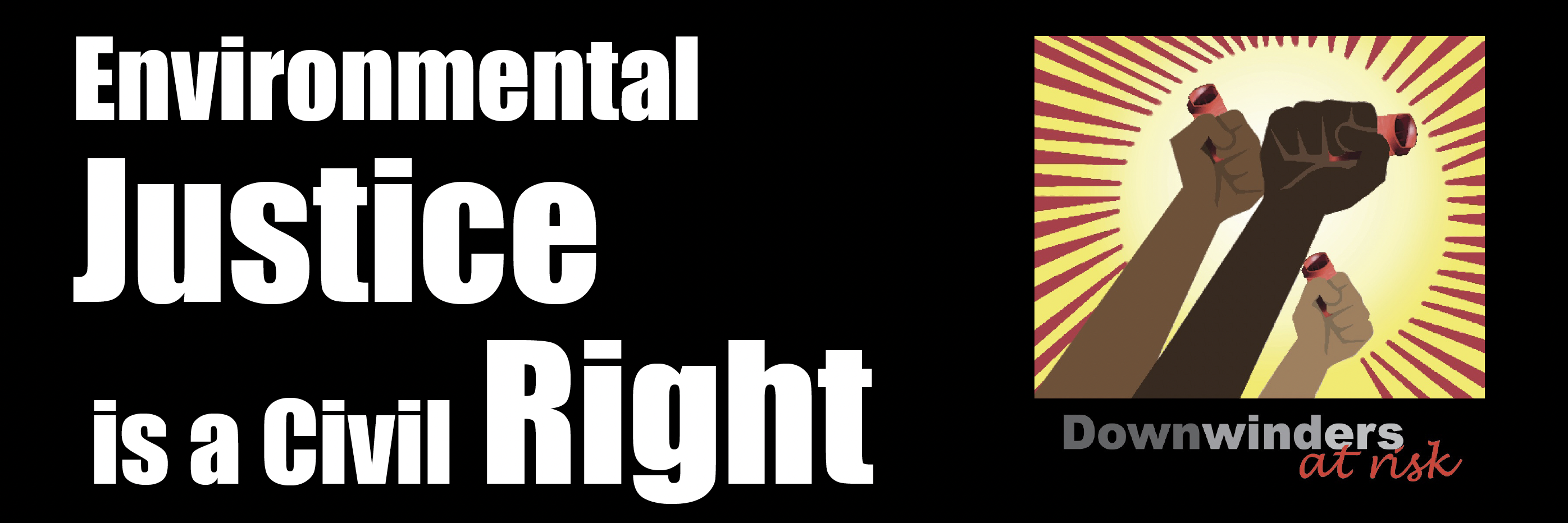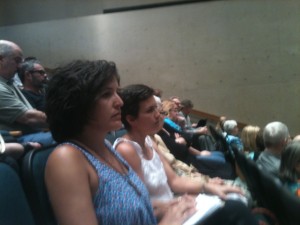Natural Gas
The High Cost of Fracking
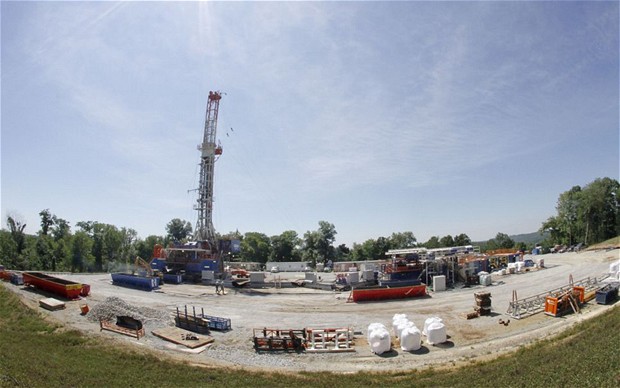 Yesterday, Environment Texas released a new compilation report in Dallas, titled, "The Costs of Fracking." There's not a lot of new information, but it does serve as a convenient catalog of the disadvantages of inviting the gas industry to town, as the Dallas City Council is considering via a new gas drilling ordinance. Every city council member should take a look, although we doubt they will.
Yesterday, Environment Texas released a new compilation report in Dallas, titled, "The Costs of Fracking." There's not a lot of new information, but it does serve as a convenient catalog of the disadvantages of inviting the gas industry to town, as the Dallas City Council is considering via a new gas drilling ordinance. Every city council member should take a look, although we doubt they will.
The report covers the impact of fracking on public health, water, air, as well as the infrastructure demands of the gas industry. Among the tidbits:
"The truck traffic needed to deliver water to a single fracking well causes as much damage to local roads as nearly 3.5 million car trips. The state of Texas has approved $40 million in funding for road repairs in the Barnett Shale region, while Pennsylvania estimated in 2010 that $265 million would be needed to repair damaged roads in the Marcellus Shale region."
Fracking can affect the value of nearby homes. A 2010 study in Texas concluded that houses valued at more than $250,000 and within 1,000 feet of a well site saw their values decrease by 3 to 14 percent.
The average public health costs of air pollution from fracking operations in Texas’ Barnett Shale region reach $270,000 per day during the summer smog season.
Here's the press release. Here's the report.
2011 was the Worst Year for Smog since 2006 in DFW. 2012 Is One Bad Air Day Away Matching It.
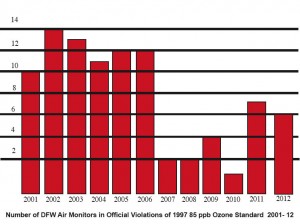 Last year's air quality death spiral in DFW was sometimes explained away as an anomaly because of the severe drought the entire state was going through.
Last year's air quality death spiral in DFW was sometimes explained away as an anomaly because of the severe drought the entire state was going through.
So what's the explanation this year?
With yesterday's high ozone levels sending a 6th monitor into an exceedance of the old 1997 85 parts per billion smog standard, DFW is just one more bad air day away from matching last year's dreadful results. Today's ozone forecast says there should be no high levels of smog in DFW today, even as the temperature reaches for a record high. But then again, they weren't predicted Thursday either.
To give you some idea how rapidly things have gone downhill for air quality in DFW the past two years, just look at the annual numbers. From 2007 to 2010, we had a total of nine monitors register official exceedances of the 85 ppb standard. That's about two monitors a year average. This turns out to be the closest we've ever come to actually meeting the standard. Officials could argue with some justification that air quality was slowly getting better.
On the other hand, during the last two years, we've had 13 monitors record exceedances of the 85 ppb standard, an average of 6.5 a year, and 2012's ozone season is not yet over. You could add up all the exceedances from the four years between 2007 and 2010 and still not equal the number we've experienced in just the last 24 months.
This is not progress.
TCEQ and the gas industry have argued for some time that gas mining couldn't possibly be contributing to smog problems since smog levels were going down as drilling was increasing in DFW. But that's not true anymore. As gas drilling has moved further and further east – into the heart of the non-attainment area, we've seen in increase in ozone concentrations, in exceedances in monitors, and monitors in the eastern part of the Metromess exceeding the standard that hadn't done so in five to seven years.
Meanwhile all other major source categories for air pollution have been decreasing their emissions. Cars, power plants and cement kilns are actually releasing less air pollution now than they were ten or 20 years ago. Only one large specific source category has increased its annual tonnage significantly over that same time – oil and gas.
Is it just a coincidence that smog is getting worse as oil and gas pollution skyrocket – not only in the Barnett Shale that surrounds DFW on three sides, but by all the new oil and gas sources now southeast of Dallas as part of the Haynesville Shale play that are blowing their pollution toward us most of the ozone season? There are now so many gas compressors in Freestone County, less than 75 miles away from the Dallas County line, that their emissions represent the equivalent of over 4 new Big Brown coal plants. What do you think the impact on air quality would be of four large new coal plants located immediately upwind of DFW? Might it look a lot like it does in 2012?
Could it be that the dirty mining of "clean" natural gas is making it impossible for DFW to meet the old 85 ozone standard, much less the new 75 ppb one? That the Devil's Bargain so many former and current elected officials made with the gas operators to grab the cash and run is now coming back to bite them and us in the air quality butt? That was certainly the conclusion of the study we publicized this last Tuesday from the Houston Advanced Research Center:
"Major metropolitan areas in or near shale formations will be hard pressed to demonstrate future attainment of the federal ozone standard, unless significant controls are placed on emissions from increased oil and gas exploration and production….urban drilling and the associated growth in industry emissions may be sufficient to keep the area (DFW) in nonattainment."
It's time for local officials to replace those cash registers in their eyes with gas masks. Because of their rush to make money, they didn't pause to understand how so much new industrial activity could produce smog just like the bad ol' days. They were being paid not to understand. And now 5 to 6 million people who still can't yet breathe safe and legal air are paying the price.
Study: Gas Drilling “Significantly” Increasing DFW Smog
 In the middle of another bad North Texas ozone season, a new study by a Houston research consortium concludes that Barnett Shale natural gas facilities "significantly" raise smog levels in DFW, affecting air quality far downwind.
In the middle of another bad North Texas ozone season, a new study by a Houston research consortium concludes that Barnett Shale natural gas facilities "significantly" raise smog levels in DFW, affecting air quality far downwind.
According to the study, ozone impacts from gas industry pollution are so large, they'll likely keep North Texas from being able to achieve the EPA's new 75 parts per billion (ppb) ozone standard.
Author Eduardo P. Olaguer, a Senior Research Scientist and Director of Air Quality Research at the Houston Advanced Research Center, concludes that, "Major metropolitan areas in or near shale formations will be hard pressed to demonstrate future attainment of the federal ozone standard, unless significant controls are placed on emissions from increased oil and gas exploration and production….urban drilling and the associated growth in industry emissions may be sufficient to keep the area (DFW) in nonattainment."
Olaguer's article describing his study was recently published in the July 18th edition of the Journal of the Air & Waste Management Association. It's the first independent study to examine specific North Texas ozone impacts from the gas industry.
Environmental groups say air pollution from natural gas sources is already making it impossible for DFW to meet even the obsolete 15-year old standard of 85 ppb. So far in 2012, five monitors have violated that level of smog despite a state plan that Austin guaranteed would reduce ozone concentrations in DFW to record lows this year. Counting 2012's failure, DFW has been in continual violation of the Clean Air Act for its smog pollution since 1991.
"This study is proof we need a regional strategy of self-defense to reduce air pollution from the gas industry," said Downwinders at Risk Director Jim Schermbeck, whose group has been leading the fight to reduce smog-forming pollution from gas sources for two years now. "TCEQ and EPA are not doing enough to rein-in these facilities. Despite their official plans, our air is getting dirtier, not cleaner because gas pollution is still under-regulated. It's time for us to do more at the local level."
Schermbeck suggested the study could make a difference in the upcoming city council vote on a new Dallas gas drilling ordinance.
"Dallas has a chance to react positively to this new evidence by adopting the nation's first policy aimed at mitigating the tons of new pollution caused by gas mining in its new drilling ordinance. That would be a very large step forward in advancing regional clean air goals."
A city-wide coalition of neighborhood, homeowners, and environmental groups has been urging the Dallas city council to require gas operators to reduce as much air pollution as they release through funding of anti-pollution measures across the city. The Houston Center study gives them a lot of fresh arguments.
According to it, "…oil and gas activities can have significant near-source impacts on ambient ozone, through either regular emissions or flares and other emission events associated with process upsets,and perhaps also maintenance, startup, and shutdown of oil and gas facilities."
In fact, just routine emissions from a single gas compressor station or large flare can raise ozone levels by 3 parts per billion as far as five miles downwind, and sometimes by 10 ppb or more as far as 10 miles downwind.
Those impacts rival the size of smog effects traced back to the Midlothian cement kilns or East Texas coal-fired power plants by previous studies.
As the study notes, "Given the possible impact of large single facilities, it is all the more conceivable that aggregations of oil and gas sites may act in concert so that they contribute several parts per billion to 8-hr ozone during actual exceedances."
This conclusion directly contradicts the stance of the Natural Gas industry and the Texas Commission on Environmental Quality, both of which deny that Barnett Shale gas emissions are large enough or located in areas that can influence DFW ozone levels.
But the Houston study is based in part on data collected by industry, as well as information from the city-sponsored "Fort Worth Study," and citizen-sponsored testing in the town of DISH in Denton County. It also uses a kind of computer modeling that allows for a more realistic understanding of how large releases from gas facilities can increase ozone pollution than the one the TCEQ uses. It's the most sophisticated challenge yet to the state and industry's claim that gas emissions do not constitute a large threat to DFW air quality.
"This is reality-based science, not the ideologically-influenced happy talk that's coming out of TCEQ these days," said Schermbeck. "Local governments in North Texas, especially those that are traditional allies of clean air, need to pay close attention and act on it."
The report is available for downloading here.
The EPA Loss in Court You Didn’t Hear About, But Could Affect You More in DFW
 Let's face it, the EPA legal team has taken a bunch of hits lately. Losses in court over the Texas Flex permitting plan and national cross state pollution rules, among others, have gotten lots of headlines, but for various reasons may not be as awful as they first sound to environmentalists.
Let's face it, the EPA legal team has taken a bunch of hits lately. Losses in court over the Texas Flex permitting plan and national cross state pollution rules, among others, have gotten lots of headlines, but for various reasons may not be as awful as they first sound to environmentalists.
But there was a recent ruling that did hit home for metropolitan areas like DFW that are a) already in "non-attainment" of the federal ozone, or smog, standard, and, b) host lots of urban gas and oil drilling. You probably didn't hear about it, but it may have more of an impact on your air here because it once again left a large loophole in current law that allows the oil and gas sector to escape emissions "off-setting."
According to the Clean Air Act, every large industry that comes to set up shop in a non-attainment area like DFW must decrease as much pollution as it estimates it will increase. This is required so that new pollution doesn't just take the place of pollution that's been reduced from industries already operating in the area. Otherwise, there would be a large imbalance between new industries and established ones that would put air quality progress in peril.
And that's exactly what's happening in DFW.
For a decade now, gas mining in the Barnett Shale has added tons and tons of new air pollution to the North Texas airshed that has not had to be off-set with reductions. While emissions from this industrial sector grew, pollution from local cars, power plants and cement kilns actually decreased. Based on past experience DFW should be making headway toward cleaner air. But we're not. For the last two years, DFW air quality progress has stagnated and even begun rolling backwards. This year we already have five monitors out of compliance with a 1997 ozone standard, compared to just one in 2010.
So why aren't gas emissions subject to Clean Air Act "off-sets" just like a power plant or cement kiln? Because nobody writing the Clean Air Act in 1970, or its amendments in 1991, anticipated urban drilling on the scale we're experiencing it in DFW these days. Nobody foresaw the establishment of a huge gas patch in a large metropolitan area with connected, but widely diffused sources of emissions spread out over hundreds of square miles. They were thinking about "stationary sources" of pollution like coal-fired power plants, refineries and the like. The amounts needed to trigger off-setting are all oriented toward these massive facilities, not lots of smaller sources that eventually equal or surpass their output. As a result, there's a huge loophole that keeps the oil and gas industry from being regulated like any other industry in a non-attainment area.
EPA has recognized this loophole and tried to close it by ruling that facilities connected by process in the gas field may be treated as one large source of pollution – the term is "aggregate." And this is the definition that a court recently shot down in a Michigan case:
"The Cincinnati, Ohio-based 6th U.S. Circuit Court of Appeals held yesterday that EPA had no basis to find that the natural gas sweetening plant and sour gas production wells owned by Summit Petroleum Corp. in Rosebush, Mich., are "adjacent" under the statute and therefore a single source just because they shared some similar functions.
It is an important case for the oil and gas industry because it is the first appeals court ruling to address a recent EPA move seeking to more aggressively "aggregate" various nearby sources of air pollution at oil and gas facilities for permitting purposes.
The court ordered EPA on a 2-1 vote to consider again whether the facilities, spread over a 43-square-mile area, are "adjacent" under the "plain-meaning of the term," which focuses only on physical proximity."
Just in case there was any doubt about why the gas industry was challenging the EPA policy of aggregating, the next sentence of the article makes it clear:
"Industry groups object because it can bring the individual sources under the umbrella of more stringent Clean Air Act permitting requirements."
Now, of course adjacent in common law means next door. But what does it, or should it mean, in environmental law? The collective air pollution being generated by that 43 square mile complex could very well be "adjacent" to your lungs a short distance downwind. But the court didn't see it that way.
That means that going into the next clean air plan for DFW – one that will, at least theoretically be aimed at the new 75 parts per billion ozone standard – EPA will not be able to "off-set" the large amounts of air pollution generated by gas mining and processing in the North Texas non-attainment area.
And that's why we have to do it ourselves, one city and one county at a time. Starting in Dallas. Starting now.
As part of the larger re-writing of the Dallas gas drilling ordinance, a very large and impressive coalition of homeowners groups, neighborhood associations, and environmental organizations have all endorsed the idea of Dallas requiring local off-sets for any pollution released by new gas facilities within the city limits. A company would have to pay for projects that would reduce as much pollution as it was estimated to release every year. Dallas would be the first city in the country to adopt such a policy, but it probably wouldn't t be the last. And it wouldn't take that many before you started seeing an impact on industry's emissions.
We have a model in the successful Green Cement Campaign of the last half decade, that also started in the Dallas City Council chambers with a first-in-the-nation vote. All it took was a dozen cities and counties passing green cement procurement ordinances to get the cement industry's attention. As of 2014, something like 300,000 tons of air pollution a year will have been eliminated because there are no more dirty wet kilns in North Texas.
We can do it again. This time with gas patch pollution. We have to. Nobody else is going to do it for us.
Gas Industry Cites Decreasing CO2, Forgets About Increasing Methane
 Maybe you've seen the headlines over the last couple of days. US Carbon Dioxide (CO2) emissions reached an historical 20 year low in the first quarter of 2012. The Federal Energy Administration attributed this decline to three factors: a mild winter, less travel, and gas-powered utility plants replacing coal-fired ones. Whereas coal was producing about 50% of America's electricity in 2005, it's only contributing 34% now, with most of that slack now being taken up by gas-generated electricity.
Maybe you've seen the headlines over the last couple of days. US Carbon Dioxide (CO2) emissions reached an historical 20 year low in the first quarter of 2012. The Federal Energy Administration attributed this decline to three factors: a mild winter, less travel, and gas-powered utility plants replacing coal-fired ones. Whereas coal was producing about 50% of America's electricity in 2005, it's only contributing 34% now, with most of that slack now being taken up by gas-generated electricity.
Gas industry representatives were quick to take credit for the reduction and use it has proof of how climate-friendly natural gas is. But they forgot something important when they did that. They didn't weigh the increase in methane releases caused by gas mining against the decrease in CO2 pollution. Methane doesn't have the lifespan of CO2 in the atmosphere, but pound per pound in the short-term, it's 25 times more potent in its climate change impact. According to climate scientist Michael Mann of the Earth System Science Center at Penn State University, “We may be reducing our CO2 emissions, but it is possible that we’re actually increasing the greenhouse gas problem with methane emissions.”
Gas Patch Pollution Linked to First Alamo City Ozone Violation
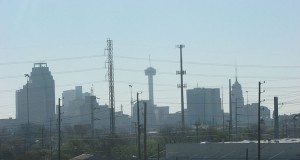 Ever since smog was an issue in Texas starting in the last 1980's, the two largest metropolitan areas have been duking it out for worst air in the state. Houston was the undisputed champion for awhile, but as of the last couple of years, Dallas-Ft. Worth has been neck and neck, and last, year, even posted worse numbers than Bayou City. No other city even came close.
Ever since smog was an issue in Texas starting in the last 1980's, the two largest metropolitan areas have been duking it out for worst air in the state. Houston was the undisputed champion for awhile, but as of the last couple of years, Dallas-Ft. Worth has been neck and neck, and last, year, even posted worse numbers than Bayou City. No other city even came close.
Until now.
For the first time ever, San Antonio has a monitor in violation of the national ozone standard. It's the new standard of 75 parts per billion, so it's still way ahead of Houston and Ft. Worth that are still have chronic problems meeting the old 1997 85 ppb standard. But it's still a milestone.
What factors helped push SA over the line? Well, theres the significant growth of the larger metropolitan area itself, and out-of-state power plants that will now not be better controlled because of Team Perry's victory over the cross state pollution rules, and oh yeah, gas patch air polluion from the Eagle Ford Shale that's up wind of San Anontio:
"Increased air pollution from the oil and gas boom of the Eagle Ford Shale is believed to be a factor, in addition to local sources and pollution coming from Mexico, East Texas and the East Coast."
Possible New Catalyst for Methane Capture in Cars and Gas Field
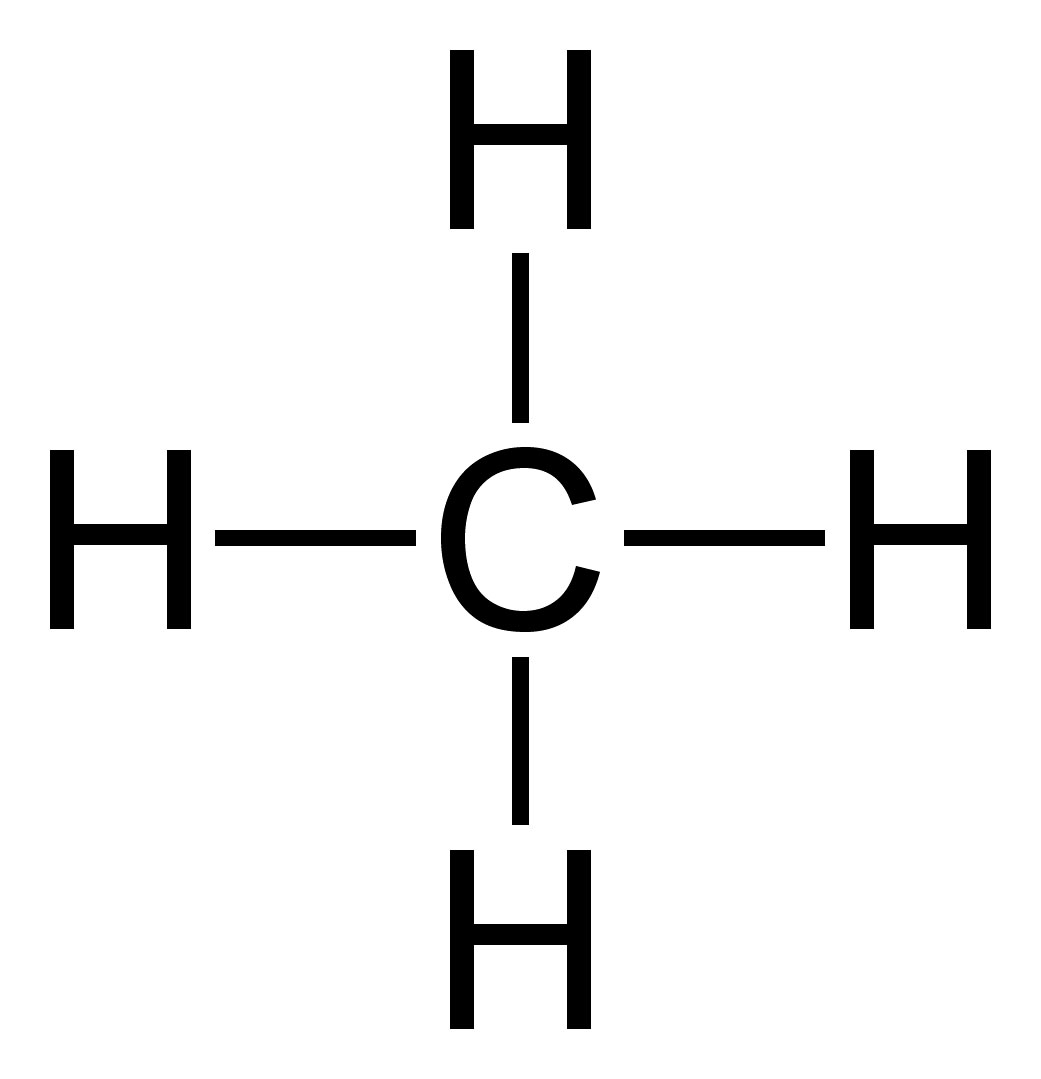 Via Chemical and Engineering News comes word that scientists from the University of Pennsylvania and the University of Trieste in Italy have developed a new low-temperature catalyst material that could remove methane emissions form vehicles as well as many different gas and oil field facilities. It would work the same way your car's catalytic converter works now – you force the emissions through a cylinder web or screen coated with a chemical designed to pick up specific molecules.
Via Chemical and Engineering News comes word that scientists from the University of Pennsylvania and the University of Trieste in Italy have developed a new low-temperature catalyst material that could remove methane emissions form vehicles as well as many different gas and oil field facilities. It would work the same way your car's catalytic converter works now – you force the emissions through a cylinder web or screen coated with a chemical designed to pick up specific molecules.
In the past, this process didn't work with Methane until you reached higher temps than are usually found in a car's engine. The breakthrough being reported solves that problem by allowing the capture of methane to take place at lower temperatures. Still in the testing phase, but we need to be on the lookout for better ways to capture methane pollution, which has been found to be something like 26 times more destructive to climate change per ton as CO2.
"Edman Tsang of Oxford University, an expert on catalysis and clean energy, says: “There is a tremendous need to remove small amounts of methane from the exhausts of gas turbines and internal combustion engines and from flue gases in petrochemical and related industries. The generally low activity of conventional catalysts and their instability at high temperatures” have made it difficult to meet this challenge, whereas the new catalyst makes a first step toward a solution. The approach needs further assessment but provides “a clear direction” for future research, he says."
Thank you, It WAS a Watershed Moment in the Dallas Drilling Fight
 Yesterday's Dallas City Council briefing on a new gas drilling ordinance was supposed to be a showdown between dueling spokespeople for pro and anti-fracking arguments. And it did provide lots of memorable exchanges and statements. But the most dramatic moment of the day came courtesy of the audience itself.
Yesterday's Dallas City Council briefing on a new gas drilling ordinance was supposed to be a showdown between dueling spokespeople for pro and anti-fracking arguments. And it did provide lots of memorable exchanges and statements. But the most dramatic moment of the day came courtesy of the audience itself.
Dallas municipal law attorney Terry Welch was coming to the end of his presentation on why the recommendations from the city's task force should be strengthened: If we're wrong and fracking turns out to be completely safe, then you can always come back and liberalize strict regulations. But you can't undo the damage once drilling takes place with insufficient safeguards. Err on the side of public health and safety.
And with that, 90% of the packed room erupted into at least 60-90 seconds of continued and loud applause. But that wasn't the moment.
Because he had ended early, even after this round of applause, Welch had time left. Mayor Rawlings noted that and said something to the effect that "If you want to keep applauding for 4 more minutes I won't objec…." The last words of that sentence had not even left his mouth before the crowd took him up on his offer, began clapping wildly again and within seconds jumped to its feet with a sustained standing ovation that went on for the longest time. It was one continuous loud and kinetic vote in favor of doing more that was aimed directly at the Mayor and Council. That was the moment.
This was no public hearing, but the public most certainly was heard. It was the first time the Council had seen the depth and breath of support for stronger drilling rules. The pent-up energy from that applause was like a Blue Norther hitting the Council horseshoe straight-on.
Likewise, it was the first time the Council's constituents had seen the depth and breath of the pro-drilling members' belligerence and hopelessly out-of-date attitudes. It produced a lot of head-shaking.
We hope to bring you selected video from the meeting over the next couple of days. Meanwhile, here's a pretty good summary from the live blogging the Morning News was posting (do tell!), as well as a more sedate article for the paper itself.
Some highlights:
– You Care. There were so many of you – in August during work hours – that they had to move the meeting from the smaller briefing room to the Council Chambers, which were quickly filled too. It was a tremendous turnout. Thank you.
– Industry isn't satisfied. It's clear now that industry is trying to rollback the required distances between homes and wells even further than what the city's Task Force recommended after their last-minute collapse in February. A variance of 750 feet is no longer adequate. Now they want 600 feet. That's 400 feet closer than a strip club is allowed to get to a home in the City of Dallas.
– The council most ardent proponents of drilling share Ireland's view that the on-going national debate has been settled in their minds, and there are no serious hazards to fracking in urban areas.
– Mayor Rawling is very much engaged in this process and issue. He was attentive, asked good questions, and kept the lengthy proceedings flowing smoothly but democratically. Whatever else you may think of him or his motives, he's focused and direct on this subject.
– Citizen advocates Scott Griggs, Sandy Greyson, Angela Hunt and Carolyn Davis all asked great questions and provided a counterbalance to the Troglodyte contingent of the Council. You might want to drop them a thank you note.
– "Sulfuric Sheffie" Kadane – In what was the most jaw-dropping exchange of the day, Councilmember Kadane asked Welch if he knew what kind of chemicals would be spilled at a fracking site. Not waiting for an answer, he offered not benzene, or toluene, or diesel fuel, but Sulfuric Acid. Perfectly harmless stuff! We use it to clean our swimming pools! A little Sulfuric Acid wasn't going to hurt anyone.
– Jerry "El Conejo "Allen – Councilman Allen was obsessed with all the "rabbit holes" Welch and other could go down in terms of the hazards of fracking and thought he had all the ammunition he needed from spending a couple of hours going down some of them via Google. These rabbit holes are known to the rest of us as research. Did Welch know that the Trinity River was full of treated sewage right now?! Did he know how many regulatory agencies oversaw fracking? Did he know that thousands of people die every year from exposure to chemicals in the home? Wasn't fracking only dangerous because people were talking about it? Above all else, he kept reminding everyone that the gas operators had already paid the city 34.8 million for lease rights and not only do they deserve something in return but that's a lot of money!
Angela "Law and Order" Hunt – The most revealing exchange all day was Hunt's cross examination of hostile witness Ed Ireland, the gas PR hack Kadane had chosen to give the industry arguments, over full disclosure of all chemicals being used in fracking. She asked Ireland if he had any problem with Dallas writing an ordinance that would demand the listing of every single chemical being used on site. Not at all, Ireland said. Of course, he added, the operators themselves don't always have the last say. They hire contractors like Haliburton to come in and actually do the fracking and THEY might have a problem disclosing their fracking fluid recipes. Three times Hunt posed the same question, never letting Ireland escape a conclusive, definitive answer. Do you support full disclosure? And Ireland gave three slippery answers that finally pulled the curtain away from the industry's premeditated deception.
We're gaining momentum. By the end of he day, there was such a stark contrast between the advocates and arguments for more protections versus the Hollywood-scripted arguments of the other side, that you could almost hear the collective council pivoting to our side, despite no vote being taken. We can't afford to be over confident, but if we keep the pressure on, we can win this fight.
Next stop – We need at least one, if not two evening public hearings on the ordinance. As you contact your city council reps, please be sure to include this request.
Now Frackers Whine About Process? Be at Dallas City Hall at 1pm To Make Them Really Mad
 According to a chain of e-mails published by the Dallas Observer, some industry supporters who were members of the Dallas Gas Drilling Task Force – the very same members who helped engineer the rollback of protections at the very last meeting without any opportunity for public comment – are all in a tizzy over council member Scott Griggs picking Task Force member Terry Welch to give today's presentation of the "Minority Report" of the Task Force recommendations beginning at 1 pm. They're claiming it's just not fair to pick someone who's actually knowledgeable about how and why the rollbacks occurred. Yep, that's some dirty dealing all right.
According to a chain of e-mails published by the Dallas Observer, some industry supporters who were members of the Dallas Gas Drilling Task Force – the very same members who helped engineer the rollback of protections at the very last meeting without any opportunity for public comment – are all in a tizzy over council member Scott Griggs picking Task Force member Terry Welch to give today's presentation of the "Minority Report" of the Task Force recommendations beginning at 1 pm. They're claiming it's just not fair to pick someone who's actually knowledgeable about how and why the rollbacks occurred. Yep, that's some dirty dealing all right.
It's really rich for those who hijacked the Task Force process to now complain about who gets to give the PowerPoint for the other side.
Who better to be able to talk about what the Task Force did and why than someone who was there? Well, the industry supporters on the Council picked good ol' Ed Ireland to give the rebuttal to Welch. Ireland showed up at exactly one meeting to testify on behalf of his clients. He has no idea what the Task Force debated prior to its votes. Maybe he doesn't look like such an inspired choice now.
Whatever the reason, this digital hissy fit is an indication the gas industry is desperate. Perhaps they're worried that their Task Force coup d'etat won't succeed. But you know what would make it a really horrible day for the fracking folks in Dallas? If all of you showed up at 1 pm at City Hall to once again vote with your bodies for stronger protections to be included in a new gas drilling ordinance, including off-sets. Come and watch what may be a watershed moment in this now two-year old fight.
Groups Sue Over Fracking Causing Rural Utah Smog Problem
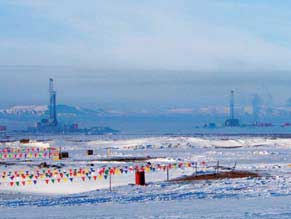 Last week five groups, including Utah Physicians for a Healthy Environment, EarthJustice, and the Southern Utah Wilderness Alliance sued the EPA for not classifying the Uintah Basin as a "non-attainment area" for the new federal ozone standard despite having plenty of evidence that the gas mining region is routinely experiencing some of the worst smog in the country.
Last week five groups, including Utah Physicians for a Healthy Environment, EarthJustice, and the Southern Utah Wilderness Alliance sued the EPA for not classifying the Uintah Basin as a "non-attainment area" for the new federal ozone standard despite having plenty of evidence that the gas mining region is routinely experiencing some of the worst smog in the country.
"It was once considered strictly a summertime problem in big cities. But winter pollution readings from the oil and gas fields of Wyoming and eastern Utah in the past seven years have shown the pollutants that create ozone— nitrogen oxides and volatile organic compounds — can also cause problems in snowy, rural areas.
Monitoring data in the Uintah Basin collected between 2009 and 2011 shows violations of federal health limits on ground-level ozone, which are set at 75 parts per billion. In 2010 and 2011, ozone levels rose as high as 121 parts per billion and 139 parts per billion, respectively."
To most of us this would mean the area is indeed due a non-attainment designation and should be required to draw up a plan to bring smog levels down. But to EPA, this only means the area is "unclassifiable," and it can put off that planning. That's why the groups are suing. And that's why it doesn't pay to think the EPA is taking care of everything.
But think about how this situation tests the claims of the gas industry operators.
In a previously pristine environment, without any cars or other kinds of heavy industry, they've now created smog on par with Los Angeles and Houston in the middle of extremely rural Utah…in the wintertime! They say they don't need new regulations; that they can voluntarily apply pollution controls. But in Utah, they either haven't done so in sufficient numbers, or those controls are clearly inadequate. Something more is needed than just voluntary controls.
Something like off-sets that require you to reduce as much air pollution as you spew.
